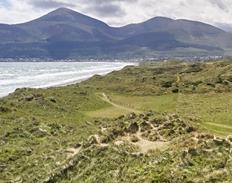SELF-GUIDED GEOLOGY : THE LECALE WAY, STRANGFORD LOUGH

MourneGullionStrangfordGeopark.com





The area we now know as Strangford and Lecale once lay deep in the southern hemisphere, drowned beneath the wide and deep Iapetus Ocean. On the ocean floor sands and muds accumulated and eventually, under their own weight, were compressed into the sandstones and mudstonesthatweseetoday.Remainsoftheseacreatures became buried too, trapped as fossils, such as the graptolites of Tieveshilly, near Portaferry.
The Lecale Way is a long distance 93 km walk that can be taken in sections and extends from the heart of Downpatrick, taking in Strangford Lough and finishing in the seaside resort of Newcastle. Tower houses, castles and ancient monuments are dotted throughout its landscape and a wealth of wildlife can be discovered along the contrasting shores of Strangford Lough and the Irish Sea.
The present freshwater lake at the Quoile Countryside Centre was created by the construction of a tidal barrier across the estuary of the River Quoile in 1957. The resulting dramatic change from salt water to fresh water is illustrated by the succession of developing habitats rich in wildlife.

ThecoastlineatBallyhornanBaydisplays excellent examples of glaciogenic sediments formed at the end of the last glaciation. These unlithified sediments have led to slope instability and the cliff is prone to mass movement especially after heavy storm activity. The extensive deposits here and along the coast suggestthattherewasarapidflowofice in the area as a result of a large tunnel valley that occupied Strangford Lough to the north.
The village of Ardglass has an easily accessible rocky shoreline of Silurian subduction zone vertical metasedimentary sequences. Built into the rocks are a number of structures that wereconstructedtodrawvisitorstothe seaside destination in the 1930s including bathing pools and a nearby bathing house.
The dune system at the Murlough National Nature Reserve is based onacomplexareaofraisedmarine gravelbarrierridgesformedacross Dundrum Bay, from reworked glacial material, in the late Pleistocene and early Holocene. Interpretations of the development of the marine gravel features of Murlough have been used in the elucidationof sea- level changes in the north of Ireland.
Killard Point is a stunning section of glaciogenic sediments that provides evidence of a rapidly flowing ice sheet entering a tidal sea. This is the only site in the Irish Sea with a spread of subglacial sediments that discharged directly and extensively into a marine environment. The evidence it provides has been used to argue that the rapid flow of ice in the area was due to its unconfined access to the sea which has an accelerating effect on the rates of flow.

